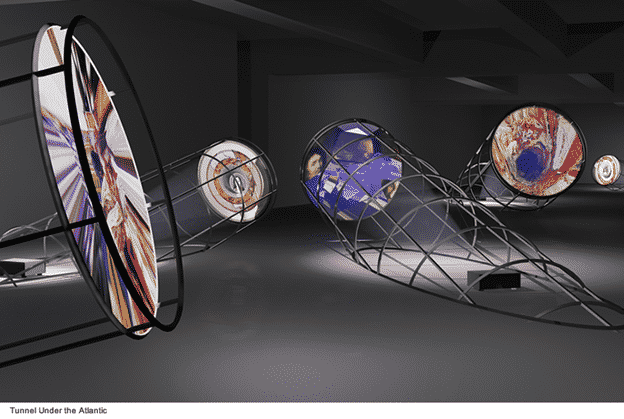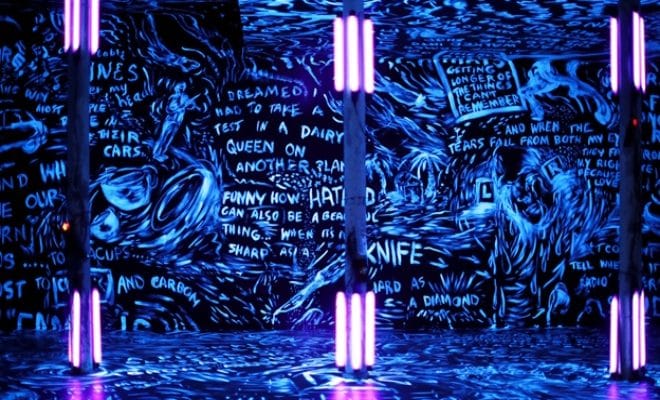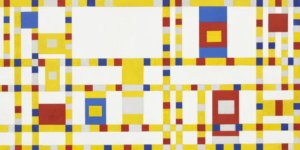Never before have people been exposed to so many different images and styles, as the world of imagery has changed quickly over recent years. And never before has the way in which visual artists create images changed so fundamentally. The scale of encroachment of technology and media into work processes is a greater upheaval than other epochs we’ve known, and it has inevitably impacted large areas of art and its making. Media art (computer graphics and animation, video, interactive art, and net art) is beginning to dominate theories of art and image. We see the rise of the computer-generated virtual image to images that seem capable of formulating an all-embracing, lifelike visual and real-time sensory sphere.
With the invention of new methods for image generation, distribution, and presentation, ever-increasing computer capabilities have transformed the greater culture of image. It has laid the foundation for virtual reality as a core medium for today’s emerging society — known as the “information society.” Nowadays, many contemporary art galleries and art museums offer virtual tours for art lovers and professionally guided walks to explore a mix of large and small scale installations, design, photography, painting, sculpture, new media, print and more.
What Is Virtual Art?
Virtual art is a term used for the virtualization of art. In other words, it is contemporary art created with the technical media developed at the end of the 1980s — computers, visualization casks, data clothes, data gloves, generators of 3D sound, digital sculpture and painting, stereoscopic screens and spectacles, etc.
The virtual media artist is a new type of artist that uses the aesthetic and innovative potential of image-creating methods and formulates artistic positions and new options of perception in today’s media revolution. Also, the virtual reality artist specifically researches innovating forms of interface design and interaction, contributing to the development of the medium, both as a technologist and an artist. In virtual art, technology and art are allied in the service of today’s complex machineries of creating images.
The development of computers and other technology has transformed artworks into a virtual world, allowing viewers to go in, participate, and rearrange them. This, in return, caused an even higher level of psychological impact and immersion because the observers are pulled directly into the virtual artwork. We can define virtual art as art that allows its viewers to immerse themselves in the artwork and interact with it through an interface of technical tools. Furthermore, many art theorists consider it a post-convergent form of art based on the union of art and technology (containing all previous media as subsets). Since virtual art consists of augmented reality, virtual reality, or mixed reality, it can also be seen in other media production aspects, such as movies and video games.
- Frank Popper on art and technology
Frank Popper, a Professor Emeritus of Aesthetics and the Science of Art at the University of Paris VII, and a historian of art and technology, is an author whose research greatly contributed to the field of virtual art. In his book “From Technological to Virtual Art” (published by the MIT press), he traces the development of interactive and immersive new media art from its precedents through modern computer art, digital art, net art, multimedia, and cybernetic art.
Popper shows that contemporary virtual art is a refinement of the technological art of the late 1900s, as well as a departure from it. What is new about contemporary virtual art is its multisensory nature, its philosophical investigation of the virtual and the real, its emphasis on interactivity, and its humanization of technology. Popper further argues that what distinguishes traditional artists and the artists who practice virtual art is the latter’s combined commitment to technology and aesthetics. Their goals concern not only society and science but also basic human drives and needs.
Virtual art has a multi-generational and panoramic reach, which Popper stresses to illustrate and explain the emergence of a techno-aesthetic. In virtual art, openness is emphasized both from the point of view of the artist and from that of the follow-up users in their reciprocating thoughts and actions.

The Birth Of Virtual Art (The 1990s)
During the 1990s, when artists managed to master the Internet, technology, and holography – visual art began to establish itself. The first virtual reality installation (“The Tunnel Under the Atlantic,” 1995) was made by Maurice Benayoun, and it was a televisual installation that created a link between the Pompidou Centre in Paris and the Contemporary Art Museum in Montreal.
This seminal artwork contained a metal tube that appeared as though it was dug into the ground. Between two tubes, there was a virtual tunnel that contained recognizable images, characteristic for both cultures. While traveling through the tunnel, the participants were able to talk to their peers from the other side of it, or even meet them in virtual reality.
That same year, Char Davies, a Canadian artist, created his virtual reality art piece called “Osmose.” It was an immersive virtual reality installation that incorporated interactive sound and 3D computer graphics, real-time motion tracking, and a head-mounted display. After putting on an electronic vest and VR goggles, the participants were taken into one of several virtual environments (all nature-inspired), including Subterranean Earth, Pond, Cloud, Forest, etc. The transition between different worlds was seamless, and most participants described the experience as overwhelmingly calming and profoundly intense, even stating that they have rediscovered a forgotten aspect of themselves.
On the other hand, Dr. Oliver Grau, a new-media art historian and a professor and dean of the Department for Image Science at Danube University Krems, defined “Home of the Brain” (1990-91) by Monika Fleischmann & Wolfgang Strauss as the first artistic VR work.
“Home of the Brain” was a virtual exhibition of philosophers’ thoughts and presented in test phases starting in 1989 with networked computers between Geneva and Berlin locations. Not only the work reflected the brand new medium at that time but also presenting a chapter of new media discourse as a philosophical debate. Fleischmann-Strauss’s groundbreaking work was awarded the Golden Nica at Ars Electronica in 1992.
Virtual Art And The 21st Century
By taking a look at the virtual art pieces created in the last few years, we can see that they greatly vary in approaches and styles. That proves that today’s virtual artists have so many more possibilities than their artistic predecessors. For example, Charles Sainty used videos of car accidents he found on YouTube to create a virtual junkyard that participants can explore by using video game controllers and Oculus Rift (VR headset). This work explores the people’s fascination with human tragedy, just like Andy Warhol’s “Disasters,” but the addition of the virtual reality experience makes it even more disturbing. Rachel Rossin, an installation and multimedia artist from New York, used virtual reality to guide the participants through her vision of hell, which was full of fragmented paintings, architectural imagery, haunted bananas, and browser logos.
Virtual Art And Technology
Technology has immensely improved since the 1990s — especially VR technology. The times of electronic vests and wires are long gone, and all you need to enter the world of virtual art from the comfort of your home is a pair of VR goggles and a smartphone.
Thanks to the progress in the interface design, the virtual art images and installations look more vivid, while the creative process becomes easier. From the artist viewpoint, the development of programs such as Google’s Tilt Brush allows them to use VR goggles and produce various works with a small electrical controller and virtual paint. This technology made virtual art more democratic, and we will definitely see more virtual artworks in the future.
- Virtual art galleries
We can define a virtual art gallery as an organized and systematic collection of virtual art pieces that offers flexibility to visitors for interaction and communication, as per their interests and needs. Virtual art items don’t actually take up any space, and they are available through pervasive computing. The progression in the development of IT and communication technology enabled the creation of virtual art galleries, which increased the degree of interactions in a manifold. What is also possible through virtual galleries are the continuous advertisements of self-expression and self-identity in the form of images, texts, or voice messages. Virtual galleries have the ability to overcome spatial and temporal constraints that exist in traditional physical art showcasing. There are no limitations when it comes to extending/altering galleries and display cases – instant change to an art collection is always possible.
Because a gallery is virtual doesn’t mean that it lacks critiques and discussion, which are well embedded in them through higher interactions. Virtual galleries are platforms that play an important role in developing the potential of art by utilizing the artistic skills of younger generations. Besides 2D representations of artworks, these galleries provide simulated 3D artifacts to provide the feeling of a fully-immersive virtual reality. We are talking about everything from digital art to replications of demolished historic buildings.
The Future Of VR And Virtual Art
The future of virtual art depends on the further development and innovations of electronic components that will become available to artists. The wave of virtual art in the 1990s instantly gained immediate attention, and installations such as Char Davies’ “Osmose” was a groundbreaking masterpiece that was all-present in the news. However, in reality, only a few hundred people got the opportunity to experience it.
At that time, virtual art started dying down because the possibilities of the technology of that time were exhausted quickly. Technology kept advancing at an exponential pace, which is why, today, the future of virtual art seems brighter than ever. Thanks to VR tools, you can now make sculptures, paintings, and murals, and are accessible to more audiences. From its ability to instantaneously stimulate all our senses, transcend space and time, as well as present artwork from multiple perspectives, the world of virtual art offers an impeccable and fascinating substitute for reality we experience. And that is a promising future for the world of art.


![[Left] Kusama with her piece Dots Obsession, 2012, via AWARE, [Right] Yayoi Kusama (Courtesy Whitney Museum of American Art) | Source: thecollector.com](https://www.artdex.com/wp-content/uploads/2024/04/Left-Kusama-with-her-piece-Dots-Obsession-2012-via-AWARE-Right-Yayoi-Kusama-Courtesy-Whitney-Museum-of-American-Art-Source-thecollector.com--300x172.png)




